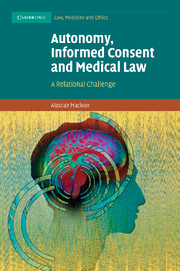Book contents
- Frontmatter
- Contents
- Table of cases
- List of figures
- Acknowledgements
- Introduction
- Part I An ethical model
- Part II Consent and the law
- 5 The legal regulation of consent
- 6 Rationalising the law and ethics of consent
- 7 Constructing consent: Future regulation and the practice of healthcare
- Summary and conclusion
- Bibliography
- Index
7 - Constructing consent: Future regulation and the practice of healthcare
Published online by Cambridge University Press: 02 July 2009
- Frontmatter
- Contents
- Table of cases
- List of figures
- Acknowledgements
- Introduction
- Part I An ethical model
- Part II Consent and the law
- 5 The legal regulation of consent
- 6 Rationalising the law and ethics of consent
- 7 Constructing consent: Future regulation and the practice of healthcare
- Summary and conclusion
- Bibliography
- Index
Summary
Over the course of the book I have explored the moral justification for the legal protection afforded to the individual's right to give or withhold consent. I have argued that any model of consent must be sensitive to the context and that consent should be situated at the heart of the relationship between the healthcare professional and the patient. Following this approach I constructed a relational model of consent. This model acknowledges the limits of individual autonomy and accommodates the bilateral obligations that exist by virtue of the professional–patient relationship.
Having explored the concept of consent, its moral basis and its contextual setting, I turned to examine the law, comparing the legal model of regulation to the theoretical model of relational consent. While the law works to a passable level it was found wanting, both conceptually and normatively. Part of the problem with the law is that it has developed within the confines of the existing common law torts of battery and negligence. This has led to a blunt system of regulation, with an unimaginative approach to consent and a thin view of autonomy. Furthermore, the institutional constraints of the common law, and the necessary association of consent and responsibility for outcome, shackle the future development of the legal regulation of consent.
In this final substantive chapter I will examine how the common law might develop in the future and I will compare that vision to the alternative regulatory approach should a relational model be implemented.
- Type
- Chapter
- Information
- Autonomy, Informed Consent and Medical LawA Relational Challenge, pp. 220 - 259Publisher: Cambridge University PressPrint publication year: 2009

